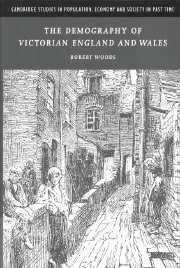Book contents
- Frontmatter
- Contents
- List of figures
- List of tables
- Preface
- 1 Bricks without straw, bones without flesh
- 2 Vital statistics
- 3 Whatever happened to the preventive check?
- 4 Family limitation
- 5 The laws of vitality
- 6 Mortality by occupation and social group
- 7 The origins of the secular decline of childhood mortality
- 8 Places and causes
- 9 The demographic consequences of urbanisation
- 10 The transformation of the English and other demographic regimes
- 11 Conclusions and unresolved conundrums
- Bibliography
- Index
- Cambridge Studies in Population, Economy and Society in Past Time
9 - The demographic consequences of urbanisation
Published online by Cambridge University Press: 07 August 2009
- Frontmatter
- Contents
- List of figures
- List of tables
- Preface
- 1 Bricks without straw, bones without flesh
- 2 Vital statistics
- 3 Whatever happened to the preventive check?
- 4 Family limitation
- 5 The laws of vitality
- 6 Mortality by occupation and social group
- 7 The origins of the secular decline of childhood mortality
- 8 Places and causes
- 9 The demographic consequences of urbanisation
- 10 The transformation of the English and other demographic regimes
- 11 Conclusions and unresolved conundrums
- Bibliography
- Index
- Cambridge Studies in Population, Economy and Society in Past Time
Summary
Because England and Wales experienced rapid urbanisation whilst also having a strong urban-rural mortality gradient it is likely that mortality rates for the country as a whole would have been adversely affected merely as a consequence of population redistribution above and beyond any deterioration that may also have occurred in the life chances of particular groups of citizens. While the general causes of urban growth and urbanisation are rather well known, the demographic consequences of urbanisation have received far less attention. In an attempt to draw together and summarise some of the salient features of Victorian demography this chapter considers the effects of urbanisation on mortality. It develops a simple model of the consequences for life expectancy of the long-term redistribution of population from rural to urban areas as well as illustrating some of the effects of suburbanisation in and around London.
First, we have to establish the broad pattern of urban growth and urbanisation in nineteenth-century England and Wales. Given the substantial volume of existing published research this should be a relatively simple matter. Tables 9.1 and 9.2 illustrate two complementary versions of what is known. Table 9.1 is based on census data post-1801 and takes a minimum population size of 2,500 for the definition of a town and thus the extent of urbanisation; that is, the percentage of the national population living in urban places. On this definition England and Wales was approximately one-quarter urban by 1751, half by 1851 and three-quarters by 1901.
- Type
- Chapter
- Information
- The Demography of Victorian England and Wales , pp. 360 - 380Publisher: Cambridge University PressPrint publication year: 2000



